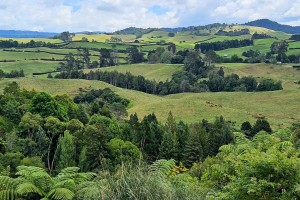Aotearoa New Zealand (AoNZ) is fortunate to have relatively high existing carbon stocks. In grazed grassland soils, which comprise about 55% of the national land area, there’s an estimated 106 tonnes of carbon per hectare to a soil depth of 30 centimetres. Even so, some AoNZ’s soils may have the potential to store more carbon. Maintaining existing carbon stocks and reducing the likelihood of future losses may be our best bet, but until now there have been scant data on which land management practices might achieve the best soil carbon outcomes for AoNZ’s productive soils, and it’s been similarly unclear how changes to management practices could contribute to mitigating AoNZ’s national agricultural greenhouse emissions.
To address this knowledge gap, researchers at Manaaki Whenua and collaborators from several other organisations led by Dr David Whitehead have, for the first time, assessed and quantified the most promising approaches to reduce soil carbon losses or increase soil carbon stocks in AoNZ’s productive grassland soils. The assessment collated all known data on nine different on-farm interventions, after which the researchers estimated the land area of AoNZ where these interventions could be realistically implemented, and calculated the potential effect of each on mitigating overall national agricultural greenhouse gas emissions.
The nine interventions were classed into three groups as follows:
Increasing carbon inputs to soil
- planting deep-rooting and diverse species in grasslands
- reducing forage cropping (which reduces carbon in paddocks where the forage is grown)
- deferred grazing, which allows biomass to build up prior to grazing.
Soil carbon protection
- water table management to reduce emissions from drained organic soils
- reducing cropping on drained organic soils
- full inversion tillage grassland renewal
- addition of active clay minerals to enhance the ability of a soil to store carbon
- enhanced rock weathering for capture of atmospheric carbon.
Integrated systems
- establishment of tree clusters integrated into grassland and agroforestry.
These nine interventions were chosen based on their suitability to be incorporated into existing grassland management practices and the capability of capturing any resulting changes in soil carbon stocks in the national inventory.
Data to confirm changes in carbon stocks from these interventions is scarce in AoNZ, so confidence in the effectiveness of each intervention was scored from “likely” to “possible” or “uncertain”.
Overall, the potential contribution of each intervention to mitigating national agricultural greenhouse gas emissions was small, ranging from less than 1% to around 2.5% over 20 years. These contributions are less than planting trees but do allow the land to continue to be used for agricultural production.
The most compelling intervention – and the one with the only “likely” confidence score – was raising water tables to reduce carbon loss from drained organic soils. Further research is required to determine how this could be best achieved and the size of the benefits under AoNZ’s unique conditions.
The researchers conclude that reducing further soil carbon losses and achieving modest increases in soil carbon stocks are possible but will require economic and political incentives that encourage the integration of multiple interventions at the farm scale.

